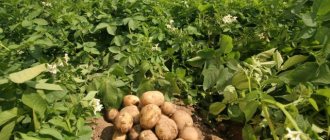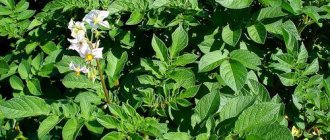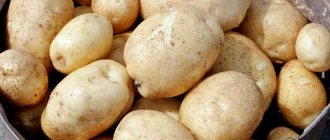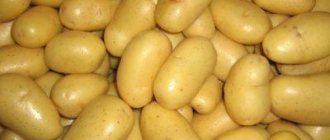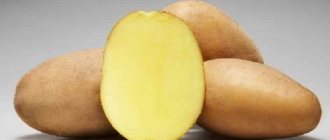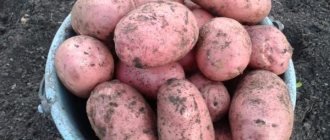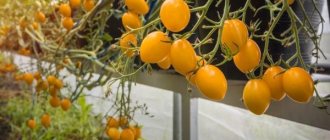Almost all amateur gardeners grow potatoes in their garden plots. Potatoes that are grown with your own hands have excellent taste, are perfectly stored and produce high yields. The varieties of Dutch selection have earned the greatest popularity, since these are high-quality table varieties, most of which are successfully sold for the preparation of semi-finished and finished products. “Romano” belongs to these varieties, giving a high yield of beautiful, regular root crops.
Seed potatoes varieties Roco, Romano, Picasso:
The history of the origin of the Romano potato variety
The Romano potato variety was developed by Dutch breeders.
This variety was included in the State Register in 1994.
The table presents data on starch content in different varieties:
| Name | Variety | % |
| Nikulinsky | Late ripening | From 12 to 21 |
| Cardinal | Late ripening | 15 |
| Rocco | Late ripening | 16 |
| Ivan da Marya | Late ripening | From 8 to 14 |
| Asterix | Late ripening | 17 |
| Borovichok | Early ripening | From 13 to 17 |
| Elmundo | Early ripening | From 11 to 14 |
| Felox | Early ripening | 16-17 |
| Bellarosa | Early ripening | 12 to 16 |
| Natasha | Early ripening | From 12 to 14 |
| Forty days | Extra early | From 11 to 15 |
| Karatop | Extra early | From 10.5 to 15 |
| Riviera | Extra early | 19,6 |
| Zhukovsky early | Extra early | From 10 to 12 |
| Farmer | Extra early | 12 |
| Crane | Mid-late | 14-19 |
| Sorcerer | Mid-late | From 12 to 15 |
| Mozart | Mid-late | No more than 20 |
| Grenada | Mid-late | From 10 to 17 |
| Melody | Mid-late | From 11 to 17 |
| Yanka | Mid-early | 14,8-15,4 |
| Giant | Mid-early | 16-19 |
| Tuscany | Mid-early | From 12 to 14 |
| Purple Haze | Mid-early | 14,4-17,2 |
| Openwork | Mid-early | From 14 to 16 |
Suitable regions for cultivation:
- Central;
- Central Black Earth;
- Volgo-Vyatsky;
- Southern;
- Far Eastern.
Peculiarities
Characteristics:
- Refers to mid-season varieties. The growing season lasts from 80 to 100 days;
- The yield is consistently average from 10 to 15 tons per hectare. Will provide a guaranteed harvest even in arid regions. The maximum yield reaches 34 tons per hectare;
- The variety is a table variety. In terms of taste, on a five-point scale it is estimated at 4.6-4.7 points;
- It has a tendency to degenerate, so constant renewal of seed material is necessary.
Description of the variety
Roots:
- Medium tubers with a flat and smooth surface;
- Root vegetables have an oval or round-oval shape;
- Light pink dense peel;
- The eyes are few, dark pink in color, superficial;
- The pulp is light yellow or cream in color;
- The average weight of tubers is 70-90 grams;
- Starch content 14-17%;
- The harvest from one bush reaches 7-9 tubers.
Escapes:
- The plant is compact, erect;
- The middle leaves are dark green, slightly wavy;
- Abundant green mass, compact branches, not spreading;
- Large reddish-violet flowers collected in corollas;
- The berries are medium-sized, rare.
Advantages, disadvantages and taste
The main advantages are:
- Excellent taste;
- Commercial appearance of root crops;
- Minimum defect rate;
- High yield;
- Duration of storage;
- Transportability;
- Resistance to mechanical damage;
- Responsiveness to feeding;
- Drought resistance;
- Excellent immunity.
Minor disadvantages include the presence of a thick peel. It protects root vegetables, but makes them difficult to cut. The Romano variety is not resistant to frost, and is also susceptible to some diseases, such as scab or nematode.
Possible difficulties
Diseases are the most difficult to control when growing potatoes. Even good varieties are susceptible to diseases, which are sometimes very difficult to combat.
Late blight is perhaps one of the most dangerous diseases that negatively affects potato yields. Plants are most often infected through rainwater or during harvesting. First, brown spots appear on the tubers, which gradually penetrate inside and lead to rotting. It is difficult to fight this disease because it spreads at lightning speed.
If all the plants are already affected by late blight, it is necessary to spray the tops with a solution of copper sulfate and dig up the tops. Seeds from infected potatoes should not be left; dug up tubers should be dried well for several hours and then kept for several weeks in a dry, ventilated area. Before identifying the crop for permanent storage, it must be sorted out and tubers showing signs of disease must be removed.
Potato cancer is a very dangerous disease. The spores persist in the soil for 20 years. When affected by this fungal disease, half of the crop dies even before harvesting, and the remaining part spoils during storage. Brown growths appear on the tubers, which in size exceed the size of the tubers. These growths rot, thereby contaminating the soil
To save the harvest, it is important to prevent potato cancer - identify foci of the disease in time and plant more resistant varieties on the site
Wilting plants are a sign of ring rot. This bacterial disease spoils the tubers - when cut, traces of decay are visible. Tubers become infected during harvesting. If you see signs of disease in a plant during germination or flowering, remove the affected plants immediately.
Common scab appears as ulcers that, when pressed, form a rough crust. The germination rate of infected tubers is very low. This disease is most common on sandy soils. To avoid encountering this disease, it is worth planting only healthy and resistant varieties.
Diseases such as rhizoctonia, dry and wet rot are also very unpleasant. All these diseases negatively affect the germination and yield of potatoes and lead to rotting of the tubers. The best protection is careful handling of planting material and the harvest itself. It is necessary to avoid mechanical damage to the tubers and store them in a dry and disinfected room.
In addition to diseases, potatoes also have a very serious and dangerous pest - the Colorado potato beetle, well known to all gardeners.
It is not so easy to exterminate a beetle, but if you do not miss the moment when eggs begin to be laid, the situation can be brought under control. The main thing is to collect Colorado potato beetles as often as possible. And the best control method is not only to collect beetles, but also to carry out chemical treatment. Today, effective drugs to combat the Colorado potato beetle are widely available. Potato processing can also be combined with foliar feeding.
Good luck in growing potatoes!
procvetok.com
- What type of potato is best to plant in the Moscow region?
- Which potato variety is the best?
- Sprouting potatoes for planting video
- Potato variety delicious
- Drought-resistant potato varieties
- Potato varieties for the middle zone
- Potato varieties: productive
- How to germinate potatoes for planting
- Time to plant potatoes
- What is the most productive potato variety?
- Ash for potatoes
- Why hill up potatoes?
- The largest varieties of potatoes
- Delicious potato varieties
- The best potato variety
- Potato varieties for the middle zone
Correct fit
Planting dates are determined by weather conditions and climatic features in the growing region. To obtain a high-quality and good harvest, it is necessary to make a competent selection and preparation of seed:
- As planting material, give preference to pure-grade tubers, the weight of which is 50-100 grams;
- When planting small planting material (weight 10-20 grams), 2-4 tubers must be placed in each hole;
- Exposing planting material to light at a temperature of +14 to +16 °C for 30 days promotes rapid germination and the production of vigorous shoots;
- It is necessary to process the planting material using mineral fertilizers, wood ash diluted in water, or growth stimulants.
HELP: For potato plantings, choose open and sunny areas. If there is high groundwater, potatoes are planted on ridges or ridges.
Increased soil acidity can be reduced with lime or dolomite flour. For heavy clay and loamy soils, add a bucket of peat or humus per 1 m2. Sandy and sandy loam soils, in addition to humus and peat, require the addition of clay soil. Coarse sand, clay, rotted manure or high-quality compost improve peat soil.
We invite you to familiarize yourself with potato varieties that have different ripening periods:
| Late ripening | Early ripening | Very early | Mid-late | Mid-early |
| Nikulinsky | Borovichok | Forty days | Crane | Yanka |
| Cardinal | Elmundo | Karatop | Sorcerer | Giant |
| Rocco | Felox | Riviera | Mozart | Tuscany |
| Kiwi | Bellarosa | Zhukovsky early | Grenada | Purple Haze |
| Ivan da Marya | Natasha | Farmer | Melody | Openwork |
| Picasso | Ariel | Minerva | Margarita | Santana |
| Asterix | Queen Anne | Veneta | Ramona | Desiree |
| Slav | Arosa | Kiranda | Dolphin | Lady Claire |
Growing
The productivity of a variety can be increased and its disadvantages can be minimized by following simple agrotechnical practices.
Seed preparation
Low resistance to late blight and susceptibility to scab is compensated by treating planting material in a solution of biological fungicides containing bacteria that inhibit the activity of fungal spores. Tubers are soaked in a solution of modern microbiological preparations, for example, Fitosporin-M or Trichodermin. Or in chemicals: Previkur Energy, Prestige.
Soil preparation
The best predecessors of potatoes are green manure, especially white mustard, winter rye, rapeseed, annual lupine, plowed into the ground no later than 3 weeks before planting the crop. They perfectly structure the soil, loosening it with their roots to a great depth, enrich the plantation with organic matter and mineral salts, sanitize the soil, thanks to the released substances with antifungal, antiparasitic and antibacterial activity.
The beds for potatoes are prepared either in the fall, adding compost or humus (4–6 kg/sq. m) and any phosphorus-potassium fertilizers, for example, superphosphate mixed with potassium sulfate or potassium monophosphate (according to the instructions) before plowing to the depth of a spade. , or 1–2 weeks before planting in April. In the spring, in addition to composted organic matter and products with potassium and phosphorus, nitrogen compounds are additionally used, for example, ammonium nitrate or urea.
Landing
Before sowing, the beds are loosened to a depth of about 20 cm. The depth of planting tubers is 8-12 cm. The distance between seedlings in a row and between furrows is 50-60 cm.
Planting care
You can increase the yield of a plantation by hilling two or three times with simultaneous weeding. Thanks to this procedure, not only does the number of suction roots in the lower part of the stems increase, but also the conditions for air exchange improve, which favorably affects the size of the filling tubers.
In temperate climates, especially in cool summers, you can do without watering the plantation. During drought and when growing crops in the southern regions, it is recommended to carry out 2-3 single waterings to the depth of the root layer.
Romano potato bushes
Potato fertilizing is carried out 2 times per season (before flowering and during the formation of tubers). The first time, the plantation is enriched with products containing nitrogen, potassium and phosphorus, for example, a solution of Nitroammofoska, a fermented infusion of grass, a solution of slurry (1:6), mullein (1:10), chicken droppings (1:25). The second time, products containing large doses of phosphorus and potassium are used, for example, ash or a mixture of superphosphate and potassium salt.
Harvesting and storage
7–12 days before digging, experts advise mowing the tops. The dug up tubers are dried, stored in containers or poured onto the earthen floor of the basement and stored at a temperature of +2 to +5°C. Seed material is stored in the same conditions, but separately.
Care
To obtain a large harvest, the following activities must be carried out:
- Water three times during the entire growing season;
- Fertilize;
- Remove weeds;
- Spud.
The most productive varieties:
Caring for the Romano variety is the same as for other potato varieties. Potato plantings are earthed up for the first time after 10 cm of seedlings appear.
Fertilizing is carried out only after watering:
- As soon as the shoots appear;
- During flowering of the tops;
- A few weeks after flowering.
REFERENCE: Loosen the soil and remove weeds the next day after the watering procedure.
Reviews about the variety
The Romano variety was highly appreciated by potato growers and gardeners for its good harvest and stable presentation of tubers. The high starch content contributes to excellent taste characteristics. It is great for making smooth, lump-free purees. You can also bake it in the oven and prepare other dishes. Peeling potatoes can cause significant difficulty, since they have quite thick and dense peels, which are best peeled with a well-sharpened knife.
Selecting potato varieties:
Potatoes grown on your own plot are much tastier than those purchased at the vegetable market. That is why it is worth growing the Romano variety in your personal garden, since it has good shelf life, can be transported and has excellent taste.
Harvesting and methods for increasing yields
You can expect to receive the first part of the harvest as early as July. However, most often the bulk ripens by early September. The tops need to be trimmed about a week before harvest. This will thicken the potato skin and increase the firmness of the fruit. Planting material should be selected at the time of harvest.
The process of drying the harvested potatoes takes from 3 to 5 days. If there is no rain, the tubers can be left to dry directly in the garden bed. However, if there is a risk of precipitation, they should be placed under canopies.
To increase productivity, special attention must be paid to seed material. It needs to be changed every five years. Otherwise, the process of tuber degradation will be observed.
A higher yield can be expected if the following conditions are met simultaneously:
- the potatoes were planted in well-warmed soil;
- When planting, large tubers were cut into equal parts, with both the pulp and eyes preserved on each;
- the material used is absolutely healthy;
- The tops are cut about a week before harvest.
